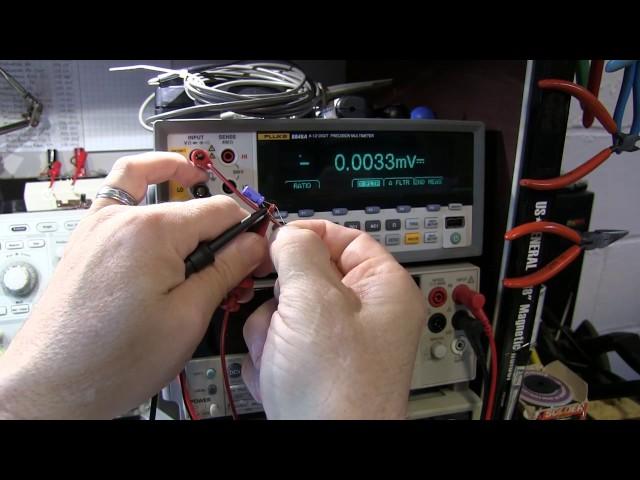
#256: Capacitor types, characteristics, and applications
Комментарии:

One way to tell the difference between Polyester and Poplypropylene film capacitors is that PP in general have much higher Q factor. This requires a proper LCR or capacitance meter, though. Common PE caps have typically a Q value of 100 - 200, whereas PP have >1000 or even >10 000, similar to PS caps and Micas. I noticed that cheap CBB (PP) caps that you can buy nowadays on Amazon, Ebay and from China, have the same Q factor as their similarly looking PE counterparts (Q around 200). I don't really know what's up with that. Maybe stick to known brands, especially for higher frequency stuff where Q matters.
Ответить
Another well researched, thoughtful video, full of practical information. Answers a lot of questions I've had when poking around devices I've torn apart and wondered about.
Ответить
I do believe it was most likely your meter charging the capacitor
Ответить![[R@UL] [R@UL]](https://invideo.cc/img/src/anItb24tZmZmZmZmMDB4MGMtay1jLTA5cz1BVGNXWklJZ1NVblZHMGpjaUU3Vlo5Ny1YRXFyY19PY3VZc1NjQV90N0dCWUtGcmtQQS9jdHkvbW9jLnRocGdnLjN0eS8vOnNwdHRo.jpg)
Awesome videos. Can you make a playlist with the Back to Basic Series?
Ответить
Thank you very much for such a well made presentation. I learn a lot from your videos. All the best, Paul
Ответить
You should merge all the knowledge presented in your videos, mix it with the way you present it and then write a book. This would became the top handbook on electronics and radiotechnics.
Ответить
Whats up with MLCCs - Multilayer Ceramic Capacitors and Single Layer Ceramic Capacitors ?
Ответить
Thank you a lot. Very detail information, with a good voice. First time i see this channel.
Ответить
Thank you for posting very informative videos such as this. Your knowledge is amazing. Keep up the good work!
Ответить
Fascinating...cheers.
Ответить
Very informative 👍
Ответить
Incredible. I wish you were my EE prof.
Ответить
Back in the 30's to 50's the RF Radio designers would use capacitor temperature coefficients to have this technique called "Evening Effect". I'm not sure if you know about this Evening Effect but if one capacitor drifts up or down the other capacitor will drift in the OPPOSITE which causes them to have this evening effect. Any reasons why this happens or how to design a circuit to have this evening effect?
Ответить
when restoring old test equipment filled with wet-tantalum capacitors, can you use appropriately sized film capacitors?
Ответить
I enjoy your videos and I tend to suggest them as reference material for both new and senior EEs that work in my group. Excellent stuff.
Ответить
How are DRY Electrolytic capacitors different than WET Electrolytic capacitors? I'm not sure why a EE designer would prefer using DRY electrolytic filter caps in the power supply because mostly I see filter capacitors use WET electrolytic. Some Multi Caps that are 2 or 3 capacitors in one package have 2 or 3 different max voltage rates in the same package which I'm not sure how each capacitor in the multi cap can have different max voltage ratings per each caps. Like one will be 300vdc the cap#2 will be 350vdc and cap#3 will be 450vdc in the same package of the multi cap. I wonder why they can do that have 3 different max voltage rating per each cap?
Ответить
Another really great video!
I am a scrounger for mica cap wherever I find them since they lately have become so expensive and hard to source. One current source I found at fairly decent price is the SMD ones from Cornell-Dubilier MC Series. Limited stock has been available at RS components. Used many of the 10pF 1000V 1210 ones with very good results.

Excellent videos!
Ответить
Thank you
Ответить
Is it always true that you can make any capacitor non-polarized by connecting a pair of them together with their negative lead and use the positive leads as the capacitor leads? You'd end up with half the capacitance of one of them, and double the voltage rating, right?
Ответить
Great Video thanks for that
Ответить
from knowing nothing bout these things few minutes ago i do now. good job explaining. thanx👍
Ответить
Thank you very much for a very informative video. Your explanation is remarkable and with full details. I really watched the whole video without blinking an eye. Your commentary is excellent, very clear voice, very good accent, and very detailed ingredients and comparisons. Thank you so much. it helped me a lot. I liked your video. Sir can you do a vlog with Motor Start and Motor run capacitors? Thanks.
Ответить
A great video, thanks!
Ответить
VERY GOOD THANKS .. Didn't know about reverse voltage sensitivity of tantalums !
Ответить
👍
Ответить
Thank you..
Ответить
Hi, I came across your perfectly shot video about capacitors, you talked about the temperature dependence, but it's a pity that you didn't point out the problem with soldering with polystyrene capacitors, it will permanently change its capacity when the terminals overheat during soldering. At present, it is no longer the case that the mark on the capacitor indicates the outer foil and it is necessary to do a hum test with an oscilloscope to identify it. I have met capacitors marked this way many times and often the outer foil was on the opposite side from the brand.
Nice day 🙂Tom

Looking forward to play with a bunch of Soviet capacitors soon. Thank you for your videos, you are one of my favorite teachers.
Ответить
Man your videos never cease to amaze me, on a lot of them I will sit there with my notebook and transcribe your note sheets 👍 the way you break down and organize the data really helps me to onboard some of these concepts. Thank you very much for what you do!
Ответить
How fast tantalums fail from aging, if at all?
Ответить
I love all this stuff but good grief its complicated 😫
Ответить
This is the sort of information that turns a noob engineer or tech into an advanced one, one of the steps in ultimately earning the title 'senior'. I've been in the business all my life, but I've already watched this twice for small nuggets I've missed.
Ответить
Nicely done, mon ami! Brought back old memories … and created a few new ones!!
Ответить
Much appreciated, very helpful. Thankyou.
Ответить
Thanks for sharing
Ответить
So nice
Ответить
Well done!
Ответить
There are NONE non polarized electrolitics. they are BIPOLAR !
Ответить
I'm a bit late to the video, but...
Tantalum capacitors ARE electrolytic capacitors. That's why they are polarized. An electrolytic process maintains the dielectric layer of both the aluminum and tantalum, so you can't reverse the polarity or the dielectric insulation deteriorates and the plates short together. The 2 basic types of electrolytic caps are aluminum and tantalum. 'Non-polarized' electrolytics are simply 2 high voltage aluminum electrolytics (thick dielectric,) that are hooked back to back.

Totally informative and useful. Thank you for a well done and explained video on the most popular and visible caps!
Ответить
Great video indeed. Cheers.
Ответить
top!
very informative

What is the differences between all the capacitors you've presented and "oil based capacitors"? Also, are there any major differences in quality/ESR/temp/triggering/storage/etc characteristics between commercial capacitors (available for everyone) and "military/medical/science/high end customers" capacitors? I know that is a huge differences between "commercial use" and military/medical for transistors....
Ответить
Answered some questions for me. Thanks!
Ответить
Well done Alan. I knew about the 3 digit classifications and knew it related to the quality of the cap. But never knew exactly which was which. Among Hi Power Tube Amp Builders there was quite a discussion about whether it was "Good Practice" to use those big Ceramic Door Knob Caps as Padding Caps for a tank circuit output. Do you have any opinions - observations on the matter ? Also when doing that how do currents divide across the caps ? Are the currents proportion to the Cap Value or Inversely Proportional ?
Bob AA6XE

How do you test how much DC voltage is passing through the Capacitor? If you apply a DC voltage on ONE end of the capacitor lead and other capacitor lead should measure Zero Volts? but what other types of test can you do to measure how much DC voltage is passing through the capacitor?
Ответить
with regards to the dielectric soakage discussion, presumably you're in a space with quite a lot of EMF generated by all the equipment and wiring. How do you know that's not just being induced in the wires to create the voltage in the capacitor just through the energy that'll be in the air?
Ответить
Thank you for producing this comprehensive and well structured overview of capacitors. Wonderful!
Ответить
Insane amount of respect for all the effort you’ve put in over the years to educate. My only question is where did you learn all of this stuff? For example this video, is this all industry knowledge? Do you browse academic journals in your spare time? Is it just experience and observation from looking at hundreds of capacitor data sheets? I hope to be one day as knowledgable as you are on anything, thanks again.
Ответить

























